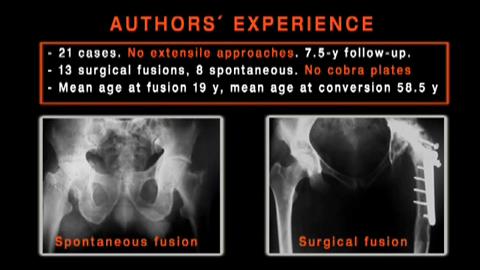Conversion of Fused Hips to Total Hip Arthroplasty
Peer review has expired on this program. It is the viewer’s responsibility to determine the educational value of this historical content.Peer review has expired on this program. It is the viewer’s responsibility to determine the educational value of this historical content.The goal of the present study is to review the indications for conversion of fused hips into total hip arthroplasty (THA); to analyze the prognostic factors found in the literature; and to illustrate our experience with a series of 21 patients, in whom we used a posterolateral approach without extensile exposure. We explain the step-by-step details of the technique and describe our experience with illustrations from clinical cases. Especially with extra-articular defects, fluoroscopy can help to locate the center of rotation and define the limits of the fusion block. Metaphyseal modular prostheses may help in patients with proximal femoral deformity. Limb-length discrepancy up to 3 to 5 cm can be corrected without complications, depending on the patient's age when the arthrodesis was performed, the extent of soft tissue retraction, or the existence of previous injuries. Correction of associated deformities may prevent early failures of the reconstruction. In our series, lower-back pain was mild or almost nonexistent after conversion. Patients with severe osteoarthritis of the knee required total knee arthroplasty (TKA) in a second procedure. Pelvic tilt improved despite severe scoliosis and degenerative spinal changes. Conversion of arthrodesis to THA is a successful procedure with a complication rate that is similar to that of revision THA. The surgeon must inform the patient that clinical and subjective improvement has to be balanced against residual limp, the need for crutches, or the possibility of TKA in patients with severe osteoarthritis of the knee. Prognostic factors should be used with caution when establishing indications and postsurgical expectations. The status of the gluteus muscles influences functional outcome, but other prognostic factors such as age, status of the neighboring joints, or position of the fusion may be more important. Younger patients may expect better functional results but more complications, as in any other THA. The relative influence of prognostic factors is, to some extent controversial, so to ensure the patient's satisfaction, it is crucial for the surgeon to establish real expectations, as in any other elective procedure.
